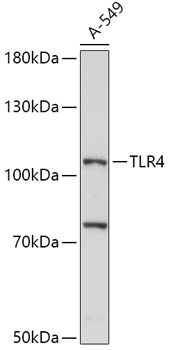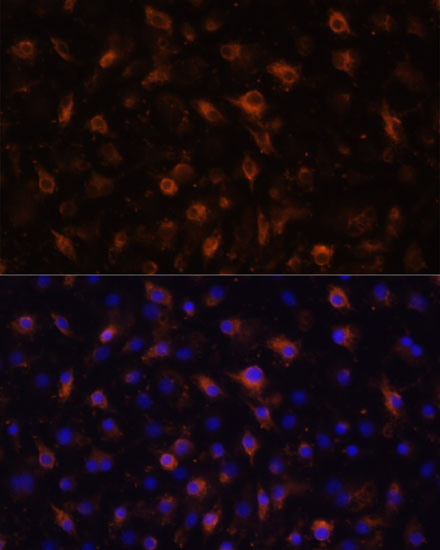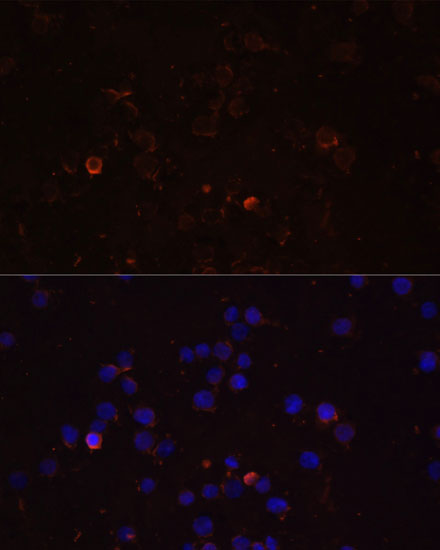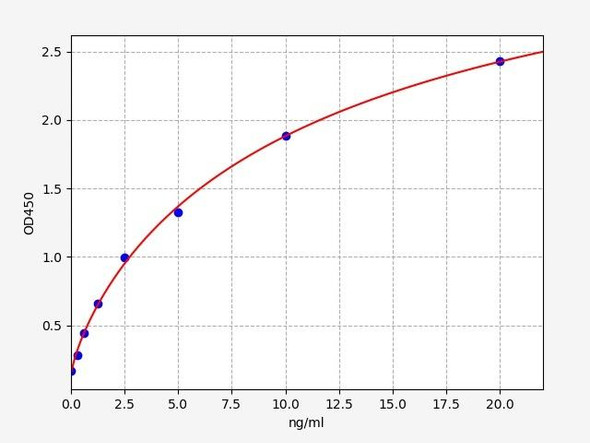Immunology Antibodies 1
Anti-TLR4 Antibody (CAB0007)
- SKU:
- CAB0007
- Product Type:
- Antibody
- Reactivity:
- Human
- Reactivity:
- Mouse
- Host Species:
- Rabbit
- Isotype:
- IgG
- Antibody Type:
- Polyclonal Antibody
- Research Area:
- Immunology
Description
| Antibody Name: | Anti-TLR4 Antibody |
| Antibody SKU: | CAB0007 |
| Antibody Size: | 20uL, 50uL, 100uL |
| Application: | WB IF |
| Reactivity: | Human, Mouse |
| Host Species: | Rabbit |
| Immunogen: | Recombinant fusion protein containing a sequence corresponding to amino acids 470-630 of human TLR4 (NP_612564.1). |
| Application: | WB IF |
| Recommended Dilution: | WB 1:500 - 1:2000 IF 1:50 - 1:200 |
| Reactivity: | Human, Mouse |
| Positive Samples: | A-549 |
| Immunogen: | Recombinant fusion protein containing a sequence corresponding to amino acids 470-630 of human TLR4 (NP_612564.1). |
| Purification Method: | Affinity purification |
| Storage Buffer: | Store at -20'C. Avoid freeze / thaw cycles. Buffer: PBS with 0.02% sodium azide, 50% glycerol, pH7.3. |
| Isotype: | IgG |
| Sequence: | LSSL EVLK MAGN SFQE NFLP DIFT ELRN LTFL DLSQ CQLE QLSP TAFN SLSS LQVL NMSH NNFF SLDT FPYK CLNS LQVL DYSL NHIM TSKK QELQ HFPS SLAF LNLT QNDF ACTC EHQS FLQW IKDQ RQLL VEVE RMEC ATPS DKQG MPVL SLNI TCQM N |
| Gene ID: | 7099 |
| Uniprot: | O00206 |
| Cellular Location: | Cell membrane, Single-pass type I membrane protein |
| Calculated MW: | 73kDa/91kDa/95kDa |
| Observed MW: | 120kDa |
| Synonyms: | TLR4, ARMD10, CD284, TLR-4, TOLL |
| Background: | The protein encoded by this gene is a member of the Toll-like receptor (TLR) family which plays a fundamental role in pathogen recognition and activation of innate immunity. TLRs are highly conserved from Drosophila to humans and share structural and functional similarities. They recognize pathogen-associated molecular patterns that are expressed on infectious agents, and mediate the production of cytokines necessary for the development of effective immunity. The various TLRs exhibit different patterns of expression. This receptor has been implicated in signal transduction events induced by lipopolysaccharide (LPS) found in most gram-negative bacteria. Mutations in this gene have been associated with differences in LPS responsiveness. Multiple transcript variants encoding different isoforms have been found for this gene. |
| UniProt Protein Function: | TLR4: Cooperates with LY96 and CD14 to mediate the innate immune response to bacterial lipopolysaccharide (LPS). Acts via MYD88, TIRAP and TRAF6, leading to NF-kappa-B activation, cytokine secretion and the inflammatory response. Also involved in LPS- independent inflammatory responses triggered by Ni(2+). These responses require non-conserved histidines and are, therefore, species-specific. Belongs to the lipopolysaccharide (LPS) receptor, a multi-protein complex containing at least CD14, LY96 and TLR4. Binding to bacterial LPS leads to homodimerization. Interacts with LY96 via the extracellular domain. Interacts with MYD88 and TIRAP via their respective TIR domains. Interacts with NOX4. Interacts with CNPY3. Interacts with HSP90B1. The interaction with both CNPY3 and HSP90B1 is required for proper folding in the endoplasmic reticulum. Highly expressed in placenta, spleen and peripheral blood leukocytes. Detected in monocytes, macrophages, dendritic cells and several types of T-cells. Belongs to the Toll-like receptor family. 3 isoforms of the human protein are produced by alternative splicing. |
| UniProt Protein Details: | Protein type:Membrane protein, integral; Receptor, misc. Chromosomal Location of Human Ortholog: 9q33.1 Cellular Component: integral to plasma membrane; perinuclear region of cytoplasm; cytoplasm; plasma membrane; lipopolysaccharide receptor complex; endosome membrane; external side of plasma membrane Molecular Function:protein binding; transmembrane receptor activity; lipopolysaccharide binding; lipopolysaccharide receptor activity; receptor activity Biological Process: I-kappaB kinase/NF-kappaB cascade; positive regulation of nitric oxide biosynthetic process; activation of MAPK activity; response to lipopolysaccharide; positive regulation of NF-kappaB import into nucleus; toll-like receptor 3 signaling pathway; positive regulation of interleukin-10 production; activation of NF-kappaB transcription factor; positive regulation of interferon-beta production; negative regulation of interleukin-6 production; positive regulation of B cell proliferation; toll-like receptor 4 signaling pathway; positive regulation of interferon-alpha production; T-helper 1 type immune response; production of nitric oxide during acute inflammatory response; positive regulation of interleukin-6 production; positive regulation of interleukin-8 biosynthetic process; positive regulation of tumor necrosis factor production; positive regulation of chemokine production; toll-like receptor 2 signaling pathway; negative regulation of interleukin-23 production; macrophage activation; detection of lipopolysaccharide; defense response to bacterium; positive regulation of transcription from RNA polymerase II promoter; I-kappaB phosphorylation; positive regulation of nitric-oxide synthase biosynthetic process; negative regulation of osteoclast differentiation; regulation of cytokine secretion; positive regulation of interleukin-12 production; positive regulation of JNK cascade; defense response to Gram-negative bacterium; positive regulation of interleukin-8 production; negative regulation of interferon-gamma production; positive regulation of MHC class II biosynthetic process; interferon-gamma production; lipopolysaccharide-mediated signaling pathway; B cell proliferation during immune response; positive regulation of tumor necrosis factor biosynthetic process; detection of fungus; MyD88-independent toll-like receptor signaling pathway; negative regulation of tumor necrosis factor production; MyD88-dependent toll-like receptor signaling pathway; positive regulation of interferon-gamma production; positive regulation of interleukin-12 biosynthetic process; negative regulation of interleukin-17 production; positive regulation of interferon-beta biosynthetic process; toll-like receptor signaling pathway; innate immune response; immune response; positive regulation of interleukin-1 production; positive regulation of inflammatory response Disease: Macular Degeneration, Age-related, 10 |
| NCBI Summary: | The protein encoded by this gene is a member of the Toll-like receptor (TLR) family which plays a fundamental role in pathogen recognition and activation of innate immunity. TLRs are highly conserved from Drosophila to humans and share structural and functional similarities. They recognize pathogen-associated molecular patterns that are expressed on infectious agents, and mediate the production of cytokines necessary for the development of effective immunity. The various TLRs exhibit different patterns of expression. This receptor has been implicated in signal transduction events induced by lipopolysaccharide (LPS) found in most gram-negative bacteria. Mutations in this gene have been associated with differences in LPS responsiveness. Multiple transcript variants encoding different isoforms have been found for this gene. [provided by RefSeq, Jan 2012] |
| UniProt Code: | O00206 |
| NCBI GenInfo Identifier: | 20140413 |
| NCBI Gene ID: | 7099 |
| NCBI Accession: | O00206.2 |
| UniProt Secondary Accession: | O00206,Q5VZI8, Q5VZI9, Q9UK78, Q9UM57, A8K1Y8, A9XLP9 A9XLQ0, A9XLQ1, B4E194, D1CS52, D1CS53, |
| UniProt Related Accession: | O00206 |
| Molecular Weight: | 73,301 Da |
| NCBI Full Name: | Toll-like receptor 4 |
| NCBI Synonym Full Names: | toll-like receptor 4 |
| NCBI Official Symbol: | TLR4 |
| NCBI Official Synonym Symbols: | TOLL; CD284; TLR-4; ARMD10 |
| NCBI Protein Information: | toll-like receptor 4; hToll; homolog of Drosophila toll |
| UniProt Protein Name: | Toll-like receptor 4 |
| UniProt Synonym Protein Names: | hToll; CD_antigen: CD284 |
| Protein Family: | Toll-like receptor |
| UniProt Gene Name: | TLR4 |
| UniProt Entry Name: | TLR4_HUMAN |






![Anti-TLR4 Antibody (CAB11226)[KO Validated] Anti-TLR4 Antibody (CAB11226)[KO Validated]](https://cdn11.bigcommerce.com/s-rd6ounxcu2/images/stencil/590x590/products/39101/43847/anti-tlr4-antibody-cab11226ko-validated__41474__10307.1706521206.jpg?c=1)


